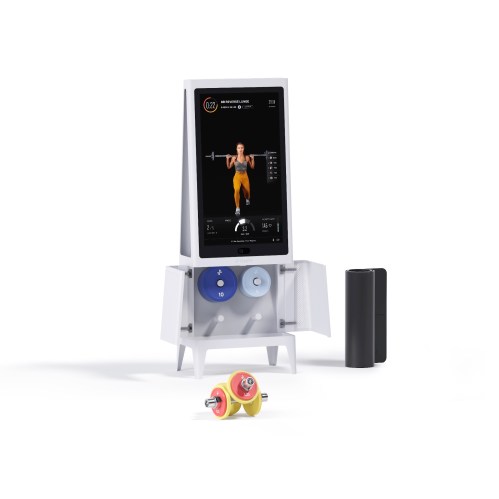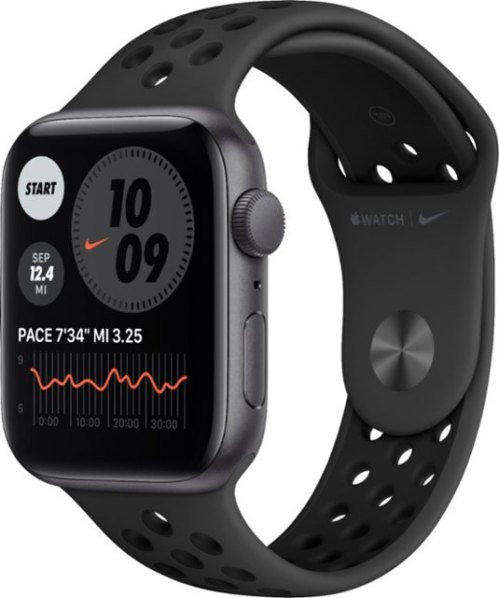Our editors independently select these products. Making a purchase through our links may earn Well+Good a commission
For As Long as I Can Remember, I’ve Hated Strength Training—But Here’s What Changed That for Me
The Tempo is a digitally-savvy connected fitness machine that actually makes strength training fun. Here's why it's worth it.

Part of the reason I played sports every chance I got in high school was that I truly, deeply hated the off-season. For one, the days spent in the sweat-soaked weight room meant it was time to crank out heavy reps and speed through HIIT bodyweight circuits. For another, a cast of cranky coaches had seen their seasons come and go too soon, and they were eager to make sure that strength-training-heavy workouts would remedy that in the upcoming schedule (cough cough: they made the exercises h-a-r-d).
Fast forward to now, and I look forward to days spent doing burpees at my house. All that’s changed? I got a Tempo machine—an AI console that utilizes a 3D body-monitoring system to provide workouts and form corrections as you go—which has become my personal trainer and source of encouragement, all in one super tech-y machine.
Tempo Studio Starter Package — $2,295.00
What should I know about the Tempo?
At-home exercise options go way back—we’ve long had access to workout tapes from Jane Fonda and P90X, as well as muscle-building equipment like the Bowflex and stripped-down weight benches. “When I talk about this category, I like to remind people that home fitness equipment and home fitness content are not new,” Jon Canarick, managing partner at North Castle Partners, a VC group that invested in the connected bike brand Echelon previously reminded us for our Well+Good 2021 Trends report. “What has changed is bringing those two things together and creating a better experience.”
And when it comes to the experience of strength training with weights and bodyweight exercises, the Tempo is the best option—bar none. Not only does it flawlessly combine equipment and content, but it also incorporates personal training and weight recommendations, making your form and the muscle-building results you see a top priority.
Here’s how it works:
1. The set-up
The Tempo is delivered to you, and experts set it up in your home. From there, you connect it to your Internet and create a profile via a corresponding app or an online profile that also identifies your workout level and goals. It has a touch screen, unlike some of its competitors, so you don’t have to download the app if that’s not your thing. You’ll be prompted to take an intro class with an instructor who walks you through the basics.
2. The console
When you’re ready to do a workout, you simply walk up to the mid-century-modern-looking console and tap the screen. You’re greeted by a welcome display that asks you to select your profile, and from there you land on the workout-selection page. There are daily live classes if that’s your thing, and there’s also a treasure trove of different modalities—HIIT, strength, yoga, cardio boxing, mobility training, and restorative workouts—body part specific training—upper body, core, lower body—as well as challenges and programs.
3. The weights
Part of the genius of the Tempo system is that all of the weights are adjustable. They’re stored underneath the console, and as you progress in different workouts, you’ll be prompted to change out your weights (more on that later).
4. The heart-rate monitor
Tempo has a heart rate monitor integration in its programming, so as you’re going through workouts, you can see your heart rate in different zones. This can be particularly helpful if you’re planning on doing a lot of HIIT and want to spike your efforts; however, the brand recently announced integration with the Apple watch, so if you have one of those, you’re set. And if not, now may be the time.
Apple Watch Nike — $400.00
You can now use your Apple Watch as a heart rate monitor when working out with Tempo.
ThirdLove Just Launched Bras That Help Balance Your Body Temperature—Here’s Why That’s a Game-Changer for Women in All Life Stages

These Are the Only Types of Underwear You Should Be Wearing, According to Gynecologists

These Are the Summer Essentials You Should Bring With You Every Time You Leave the House, According to a Derm and an RD

How much does the Tempo cost?
Good Q. It depends on which package you buy. Here are the details for each of them.
1. The Starter 4-Piece Package, $2,295
The starter package is what I have, and it works great for me. Unless you really want to work out with a weight bench or see yourself frequently using a barbell, this is your best bet because you can utilize the floor to do so many different movements. It comes with the following items:
- A cushy workout mat
- 2: 7.5 lb Dumbbells
- 4 Dumbbell collars
- Weight plates for dumbbells
2. The Plus 9-Piece Package, $3,045
If you’re into weight lifting and know you’ll use the barbell and extra plates, I salute you. This 9-piece set is also a great buy because it comes with recovery tools like a foam roller, so you can lift and then roll your muscles into a state of ooey-gooey tension-free bliss. It comes with the following items:
- A cushy workout mat
- 2: 7.5 lb Dumbbells
- 6 Dumbbell collars
- Weight plates to boost dumbbells
- Heart rate monitor
- Foam roller
- Folding weight bench
- Weight plates for dumbbells
- 2: 25 lb competition plates
3. The Pro 13-Piece Package, $3,795
For the born-to-be-buff crowd, this is the package for you. It comes with a squat bar, recovery gear, and all the (kettle) bells and whistles. I can see this package working for someone who’s been lifting for a while and wants to take that to the next level by adding gear to their home.
- A cushy workout mat
- 2: 7.5 lb Dumbbells
- 6 Dumbbell collars
- Weight plates to boost dumbbells
- Heart rate monitor
- Foam roller
- Folding weight bench
- Weight plates for dumbbells
- 2: 25 lb competition plates
- 2: 45 lb competition plates
- Adjustable kettlebell
- Folding squat system
The Tempo app
Once you have your system, access to the Tempo app and operating system costs $39, which is relatively the same as both Peloton ($40) and a bit more expensive than an option like Myx ($29). It is important to note this cost, however, as you really do need the membership in order for the technology to function.
What are the workouts like?
I’ve tried out a few of the different workout types, and love the HIIT classes, so I’ve mainly stuck to that type of content. The classes blend bodyweight and weighted movements over the course of the class so you don’t ever really get stuck doing one thing.
Intensity
In terms of the intensity, I’ve usually selected intermediate classes that are pretty middle of the road in terms of difficulty (Dear Ali: That’s what intermediate means). The “Advanced” class that I took was challenging, but not the hardest thing I’ve ever done in my life. So all-in-all, there’s something for you here, and you can turn it up or down depending on how you feel.
Trainers
One thing I like about the Tempo machine is that the trainers are all really encouraging without being too sappy or over-the-top. You can also turn the music up so that it’s louder than the trainers’ cues if you just want to jam out and sweat, or alternatively, you can really focus in on what the trainer is saying.
Modifications
I’ve talked a lot about the modifications, and it’s worth noting how that happens within the system. When you use improper form, a call-out comes up on the screen and tells you to adjust with specific instructions on how to do the move correctly. One that I frequently get is allowing my knees to come over my toes when I’m squatting. With the nudge, however, I’m able to stick my butt out and feel the full impact of the move. It gives you credit for fixing the move on screen so you know you can keep moving or keep tweaking your form.
Rep count
Another thing I like about the on-screen experience is that you’re able to see how many reps you complete over the course of a set. This really allows you to stay honest with yourself and not slack off as the class goes on.
Weight recommendations
Before you’re about to do any round of moves, the Tempo suggests the weight that you should use to complete the round. The weight system is, again, color-coded and the collars easily slid off and on so you can change your weights while you catch your breath. After the set, you can tap on the screen to say whether or not the weights were right or not for the moves that you tried so the system gets smarter and can make better recs for you in the future.
Is the Tempo worth it?
While upwards of $2K for equipment alongside a monthly membership isn’t exactly affordable, I’ve found that I’ve consistently used the Tempo equipment and workouts more than any others in the past. Not only are the workouts engaging, but they much more closely resemble studio fitness classes or gym workouts than other strength training apps I’ve tried. (It’s not super fun to always have your neck cricked to see the next move on your phone, right?)
In addition to displaying the moves on a big screen, the 3D motion technology, which allows the machine to correct my form in real-time has helped me to get more from my workouts than I have in the past. It’s also kept me coming back more frequently as well because I don’t have weird injuries from doing a given move with poor form.
The only other thing to note is that you can lift weights at a gym, and you can do bodyweight movements without purchasing anything at all, so there are ways to replicate the types of moves you’ll be doing without investing in a pricey machine. But that also takes work, planning, and a trainer-like dedication to form.
However! If you, like me, simply want to show up, train consistently, and see the muscle-boosting results of your efforts—with variety in your routine, at that—this buy is a no-brainer.
Tempo Studio Starter Package — $2,295.00
Oh hi! You look like someone who loves free workouts, discounts for cutting-edge wellness brands, and exclusive Well+Good content. Sign up for Well+, our online community of wellness insiders, and unlock your rewards instantly.
Sign up for the Well+Good SHOP Newsletter
Get exclusive deals on wellness, beauty, fitness, and food products that have been hand-picked by our editors.
Got it, you've been added to our email list.









